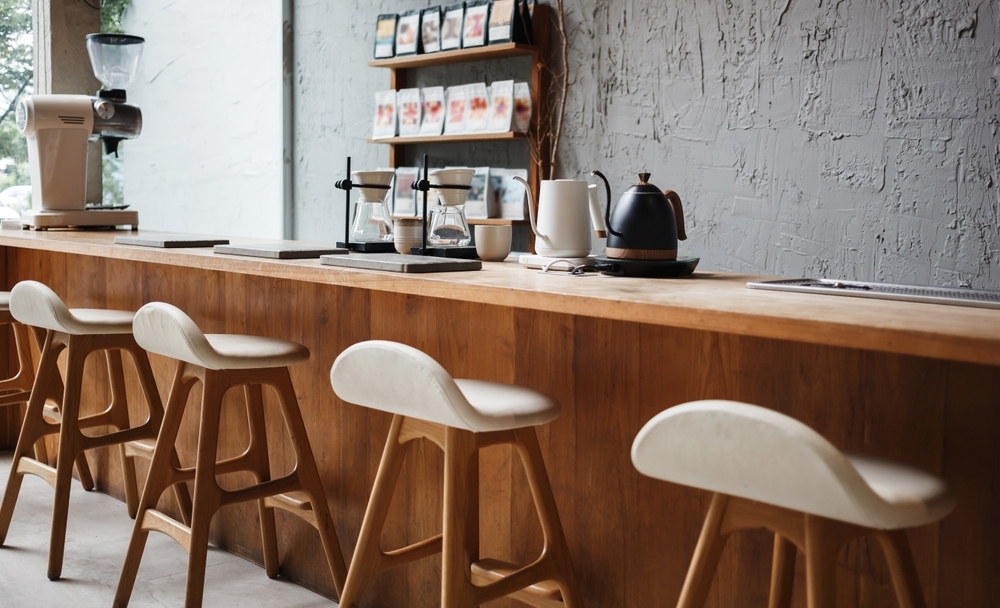Mastering Your Cafe Business Plan: Essential Steps for a Thriving Cafe
By Nikita Nielsen · 5. March 2024
In the competitive landscape of cafes, a well-conceived cafe business plan is your lifeline to success.
Are you ready to turn your cafe dream into a profitable reality?
This guide offers a straightforward navigation through the critical aspects of building a business plan that solidifies funding prospects and paves the way for operational triumph.
Key Takeaways
- Crafting a standout cafe business plan is key—it’s how you lock down funding, stay ahead of the curve in catering to your customers’ tastes, and keep your business strategies sharp.
- Understanding your market is crucial. Get into market research, get comfortable with trend predictions, and keep an eye on what the competition is up to, so you can navigate your way to the top.
- The heart of your cafe comes down to location and layout. Find a place that feels just right, then set up a space that’s as welcoming to your customers as it is efficient for your team.
Crafting the Perfect Cafe Business Plan
 Cafe Business Plan
Cafe Business Plan
Just as the first sip of well-brewed coffee☕️ sets the tone for a great day, a well-structured cafe business plan lays the foundation for a thriving shop.
It’s your ticket to securing funding, aligning your strategic planning with your foundational objectives, and guiding your cafe on a clear path to success.
Your business plan is not a static document gathering dust on a shelf. Instead, it’s a dynamic tool, adapting to market shifts, industry trends, and customer preferences.
Incorporating feedback from experienced cafe and coffee shop owners or consultants, the plan should be regularly evaluated and updated, especially during the initial stages.
Why a Business Plan Matters
A business plan serves as a foundational document for new cafe owners. It provides a clear roadmap for achieving your cafe’s objectives, improving decision-making, and enhancing financial sustainability – all crucial aspects of a successful business idea.
Utilising a business plan template can help streamline this process and ensure you cover all necessary aspects.
Your business plan can also be your golden ticket to securing funding. It serves as proof of the potential success🚀 of your cafe, convincing potential partners, lenders, and investors that your cafe is a worthwhile investment.
However, keep in mind that your business plan, including your marketing plan, is a dynamic tool.
Regularly revising it allows you to identify opportunities for improvement and tweak strategies in line with customer needs and evolving market conditions.
Key Components of a Cafe Business Plan
Just like a perfect cup of coffee, a comprehensive cafe business plan has several key ingredients. It should include:
- A thorough market analysis
- A robust marketing strategy
- Detailed financial projections
- A meticulous operational plan
Think of the sample menu in your business plan as a sneak peek into the offerings of your cafe.
It should communicate the types of food and beverages you aim to serve, detail the required equipment, and outline the proposed supply chains.
Meanwhile, outlining your cafe’s staffing needs helps inform accurate financial estimates, while detailing your experience and qualifications underscores your business credibility.
Market Research and Analysis
 Market Analysis
Market Analysis
Market research📈 and analysis are vital to your cafe’s success. It’s about understanding the current trends, gauging competition, and getting into the minds of your target audience.
Did you know that sales in the grab-and-go coffee segment are projected to expand significantly in the near future?
This indicates a strong consumer trend towards valuing quick and convenient beverage options.
As of now, the UK coffee shop market has achieved an estimated value of £10.1 billion, with projections indicating that it’s set to reach a whopping £15 billion turnover by 2025.
With the market growing at such an impressive pace, a thorough competitive analysis within your cafe business plan can help you position your coffee shop for success in the market.
Understanding Your Target Audience
As the proprietor of a cafe, your mission is to do more than just pour a mean cup of joe; it’s about curating a diverse menu and crafting an ambiance that strikes a chord with your patrons.
By analysing customer demographics such as age, income levels, and lifestyle, you can diversify your offerings to include a range of beverages, food items, and even retail products that align with their preferences and enhance their overall cafe experience.
But it’s not just about understanding who they are. It’s also about creating an environment they will find appealing and comfortable.
The cafe’s interior design must cater to your identified target audience’s atmosphere preferences.
So, if your target audience loves a relaxed and cosy environment, your cafe design should reflect just that.
Analysing Competitors
Understanding your competitors holds as much significance as understanding your customers.
A detailed analysis of your competitors can help you identify market gaps, understand their strengths, and devise strategies for effective market positioning.
Your competitors are not just other cafes but could also be donut shops, bakeries, or sandwich shops.
By understanding their pricing and offerings, you can better position your cafe in the market and increase its chances of success.
Location and Design: Setting the Stage for Success
 cafe interior
cafe interior
The location and design of your cafe or coffee shop play a crucial role in its success. It’s like the setting of a play; it sets the mood and greatly affects the story’s outcome.
So, finding the right location is essential as it significantly impacts your cafe’s accessibility and customer traffic.
But it’s not just about where you set up shop. It’s also about how you set it up. A well-designed floor plan can improve customer flow, ensure efficient staff movement, and provide comfortable seating arrangements.
Finding the Ideal Location
Selecting the right location for your cafe is akin to finding a hidden gem. It’s not just about the spot itself; it’s about the surrounding environment, the local culture, and the potential for creating a community hub.
Your cafe’s location should be:
- Highly visible
- Easily accessible
- Safe and secure
- Attract customers
- Ensure ongoing customer flow
- Proximity to public transportation and parking
It’s also about sustainability. While a prime location might come with a hefty price tag, it’s important to balance rental and operational expenses with the potential return on investment.
After all, the location chosen should sustain your business financially.
Interior and Exterior Design
After securing the perfect location, it’s time to focus on designing your cafe. The exterior and interior design of your cafe should work together to create a coherent brand experience.
This consistency effectively communicates your brand’s values and engages your audience.
Consider the following elements to enhance the ambiance of your cafe:
- Choice of colours
- Lighting
- Furniture
- Decor
These elements can significantly influence the mood within your cafe, dictating the ambiance and comfort felt by patrons.
Outside, creative window displays and strategically placed lighting can enhance your cafe’s exterior ambiance and attractiveness, intriguing passersby and setting a welcoming tone.
Financial Planning and Funding Options
 financial planning
financial planning
Navigating the financial landscape of a new cafe venture is akin to assembling a complex puzzle.
It requires a keen understanding of both the initial investment and the long-term financial strategies.
Your business plan should encapsulate comprehensive financial projections, including startup and operating costs, to captivate lenders and investors with the viability of your business.
Start-up costs can vary greatly, influenced by factors such as:
- the quality of equipment
- types of food and drinks offered
- staffing
- acquisition of licences
- space rental expenses
- marketing initiatives
But fear not, as there are various funding opportunities available to help you cover these costs.
Estimating Start-Up Costs
Estimating start-up costs for a cafe is a bit like brewing a perfect espresso shot – precision is key, but you don’t want to overcomplicate things. It involves:
- Carefully itemising anticipated expenses to avoid financial surprises down the road.
- Separating personal and business finances early on to maintain clear financial records.
- Budgeting for a financial ‘cushion’ to ensure you can cover both business and personal expenses, especially in the early months.
In the UK, the average startup costs for a cafe can be significant, but they are a necessary investment into the dream of owning a cafe.
While these costs can vary depending on a multitude of factors such as location, size, and the level of finish desired, it’s wise to prepare for a substantial initial outlay.
- The lease for the building
- Furnishings
- Essential technology
- Staffing and payroll
- Inventory
- Marketing
- Insurance and licences
Funding Opportunities
Now that you’ve tallied up your startup costs, it’s time to explore funding opportunities. These can range from government funding to local loans to bootstrapping the business.
For example, there are government-backed alternative funding schemes that provide financial support to small businesses, including coffee shops.
Remember, a solid business plan and detailed financial projections are key to securing funding for your cafe.
Marketing Strategies for Your Coffee Shop
 Coffee Shop marketing
Coffee Shop marketing
Marketing strategies for your cafe need to be carefully crafted and tailored to your business’s unique needs.
Your marketing strategy should be centred on establishing a robust online presence, fostering engagement with your target audience, and encouraging community involvement and partnerships.
Remember, a clear, cohesive brand is crucial for attracting customers and creating regulars. So, your memorable brand identity must be reflected in your business plan.
Social Media and Digital Marketing
In the current digital era, social media serves as an influential tool for marketing your cafe.
Regular posting of engaging content, encouraging user-generated content, and collaborating with influencers can significantly enhance customer engagement and interest.
Remember, it’s not just about promoting your cafe. It’s also about:
- Engaging with customers through social media conversations
- Paying attention to their feedback
- Embodying excellent customer service
- Leading to idea generation and improvements
Community Involvement and Partnerships
Community involvement and partnerships can provide your cafe with an extra boost, much like an extra shot of espresso in your latte.
Hosting events, collaborating with local businesses, and engaging in social activities can help build a positive reputation and attract patrons who value community-conscious businesses.
Offering free coffee during special events can also contribute to this positive image.
Hosting events such as coffee tasting sessions, latte art workshops, and themed evenings like poetry nights or live music can attract new customers who visit cafes and solidify your own coffee shop as a community hub.
Plus, collaborating with other local businesses, such as partnering with nearby bakeries for fresh pastries or featuring work from local artists, enriches the independent coffee shop experience and supports the local economy.
Staffing and Management
The right mix of staff is key to the seamless operation of your cafe. Hiring individuals who are reliable, hard-working, and demonstrate strong customer service skills can make all the difference.
But it’s not just about hiring the right people. It’s also about managing your staff effectively.
To ensure smooth operations during busy times, consider strategically hiring extra staff to handle peak periods, emphasising the need to hire slowly to effectively evaluate staff performance.
Training and Development
Training and development are vital for bringing out the best in your staff. An effective onboarding process and ongoing training ensure your staff are updated on policy changes, industry regulations, and can adapt to various roles within the cafe.
Providing ongoing training ensures staff are updated on policy changes and industry regulations, while cross-training enhances flexibility.
These development opportunities improve job satisfaction and overall cafe productivity.
Legal and Regulatory Requirements
To legally operate a cafe in the UK, registration with the local authority is required at least 28 days before beginning food operations.
While a food hygiene certificate is not mandatory for starting a food business, obtaining a qualification is encouraged for better knowledge and adherence to food laws such as allergen information provision and proper food handling practices.
Licensing and Permits
Brewing the perfect cup of coffee requires not only the right equipment but also the appropriate permissions. The same applies to your cafe.
You need to check the current commercial classification, get planning permission if required, and apply for the appropriate licence through Gov.uk.
Gas and Electrical Safety Certificates are also required for your coffee shop, with an annual check by a Gas Safe engineer for gas equipment and regular PAT testing for electrical equipment.
Food Safety and Insurance
Food safety regulations in the UK require that anyone involved in food handling and sales must ensure food safety, maintain proper training, and possess a food hygiene certificate.
Regular food safety training should be updated every three years, and adherence to allergen laws, including allergen information provision and labelling rules, is a must.
Insurance is another crucial aspect of running a cafe. Cafes must secure comprehensive insurance coverage, including Employers Liability Insurance, Public Liability Insurance, and Product Liability Insurance to safeguard against the diverse risks involved in running a food business.
Summary
Crafting the perfect cafe business plan might seem like a daunting task, but with the right blend of strategic planning, market research, and operational management, it becomes a rewarding journey.
From picking the right location to creating a well-designed cafe, from financial planning to securing funding, from marketing strategies to community involvement, every step brings you closer to the dream of owning a thriving cafe.
Remember, your business plan is a roadmap to your success🏆. It guides you through the journey, helps you navigate challenges, and leads you towards your goal.
Embark on this exciting journey to craft the perfect cafe business plan!
Frequently Asked Questions
How profitable is a small cafe?
A small cafe can be profitable, with an average profit margin of about 2.5 percent, but increasing sales volume is key to improving profitability.
How do I write a business proposal for a cafe?
Get brewing on your business proposal by using a cafe or coffee shop business plan sample. Be sure to cover key sections like executive summary, business overview, market analysis, and financial forecast.
How much money do I need to open a cafe in the UK?
You’ll need between £20,000 to £100,000 to open a cafe in the UK. It’s no small change, but it’ll be worth it for that perfect cup of coffee!
What is the importance of a business plan for a cafe?
Having a solid business plan for your cafe is crucial as it sets the direction for your goals, shapes your decision-making, and secures financial stability.

